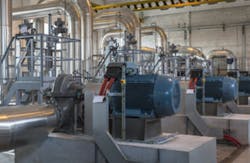Larry Bachus
(“The Pump Guy”)
I was in the Johannesburg, South Africa airport a while ago, awaiting my return flight home and decided to check my emails. In my inbox was a message from Phil J., a name I couldn’t immediately place. The email subject was a question, "When is a pump problem not a pump problem?"
I opened the message and read the answer, "When it is a pipe problem!"
Just then, they called my flight. I closed my laptop and boarded the plane.
In the air over the Atlantic Ocean for 16 hours, I pondered Phil’s message between the videos, Sudoku puzzles, and naps before landing in Atlanta. I remembered Phil was the principal mechanical engineer at a power management company. He had an urgent pump problem in a thermal oil application at a solar power generating plant in California.
My work and travel schedule was complete, so I recommended my friend and frequent pump collaborator Don Densmore for the project. When I arrived home, Don’s report of the project was waiting in my inbox. So, I’ll let Don’s tell his story in his own words:
"It seems as though I’ve heard time after time that someone was in desperate trouble because the pump just wasn’t working properly. That’s right! The darn pump just didn’t work as it was supposed to.
My response is always the same. "I’ll go there and find out why the pump wasn’t working as designed." Sometimes it was true that the pump didn’t perform as designed, but rarely was it because of a faulty pump.
I received a phone call from my longtime friend Larry, asking me if I could do him a favor and visit a jobsite to determine why a pump was not pumping. This location was only about 80 miles from my house in a town called Daggett, California (just outside Barstow). It was critical that someone get there quickly.
Larry lives in Tennessee, and the engineering department of a large co-gen solar company had asked him to come and resolve the problematic pump. Larry was due to leave shortly for Africa, so he called me to follow up with the company involved.
READ ALSO: Pump Guy Mailbag—Do I Need a Booster Pump?
I called them and spoke by conference call with a battery of engineers. They were convinced that something had happened to the pump and needed someone to determine what should be done. We agreed on a fee and I promptly drove to the job site in Southern California.
Upon arriving, it was apparent they were anxious to get this pump into production as soon as possible. I met with their site engineers and they were willing to do whatever was necessary to ‘fix the pump.’
The pump had been in service for 25 years. It was a Byron Jackson, heavy-duty, single-stage pump with a 20" suction and discharge, both located vertically at the top of the pump. It was one of three that operated in parallel when it was required for more flow. However, one pump was piped in a different configuration than the others.
This pump was insulated to handle thermal (very hot) oil that was being circulated from the solar panels.
I noticed the inlet piping was not installed in a manner that would not be considered "good engineering." However, it had been operating like that for 25 years. With that in mind, I asked them to start the pump and let me observe the differential pressure to determine what is going on.
As the speed ramped up on a VFD start, I could see the pressure on the inlet was not as high as it was designed to be, and the inlet pressure dropped steadily as the speed increased. I could also hear the pump was definitely cavitating and not pumping as it should. We let the pump run for a couple of minutes and then shut it down. The local managers wanted to remove the pump and get it repaired.
The pump was fed from a manifold located about 100 feet away and positioned about 10 feet below the pump base. The pipe leading to the pump had numerous elbows with inclines and declines leading to a 20" gate valve and the pump suction nozzle. There was no discernable logic to the suction pipe arrangement.
We installed a pressure gauge at the upstream manifold and another gauge at the gate valve just before the pump suction nozzle. We started the pump, and noticed a large difference between the two gauges.
The elevation differential across the system justified a couple of PSI pressure drop between the gauges. The numerous 90-degree elbows might have accounted for another two or three PSI pressure drop. But there was nothing to justify the 40 PSI pressure drop across the suction pipe system. We installed some more strategic pressure gauges in the pipe system and determined the major pressure drop was in the vicinity of the suction gate valve, which was totally open.
We removed the thick pipe insulation before the suction gate and found a hidden "Y strainer" at the entrance to the suction gate valve. No one knew it was there. The strainer didn’t appear on the original engineering drawings, and the strainer’s existence was covered by thick pipe insulation many years ago. After 25 years, the strainer basket was completely full of sludge and oil clots. The clots were backing up into the suction pipe before the strainer.
At first, I recommended they remove the strainer from the pipe. There was no time to build a spacer pipe or spool to replace the strainer in the suction pipe scheme. So, I recommended they leave the strainer in the pipe, but without the basket. Besides, there were strainers in other parts of the pipe system to capture the clots.
In closing, the client started the pump. The suction pressure was adequate with margin above the NPSHr. As I drove home, the pump was running like new. The vibrations and stress had disappeared.
In all my years of solving problems with pump systems, I have found that almost 70 percent of the ‘pump problems’ are not really pump problems, but system problems. Therefore, you must understand the pipe system you work with and always have a gauge on the suction of the pump, as well as a gauge on the discharge."
— Don Densmore
Don has been a good friend for many years. Now retired, he still shows up at my California seminars to hang with the participants and talk about pumps. Don is responsible for some of the unseen pumps and pipe that make the impressive water shows and fountains on the strip in Las Vegas. Twenty years ago, Don and I ghost-authored a pump book for a training company, and we both lost money once on a sour real-estate deal. Ouch!
Larry Bachus, founder of pump services firm Bachus Company Inc., is a regular contributor to Flow Control magazine. He is a pump consultant, lecturer, and inventor based in Nashville, Tennessee. Mr. Bachus is a retired member of ASME and lectures in both English and Spanish. Contact him at [email protected].
The next Flow Control Pump Guy Seminar will be in Indianapolis, Indiana, June 16-18, 2015. Contact Matt Migliore at [email protected] for specifics. For my full schedule of upcoming pump trainings, visit www.bachusinc.com/seminars.html.




